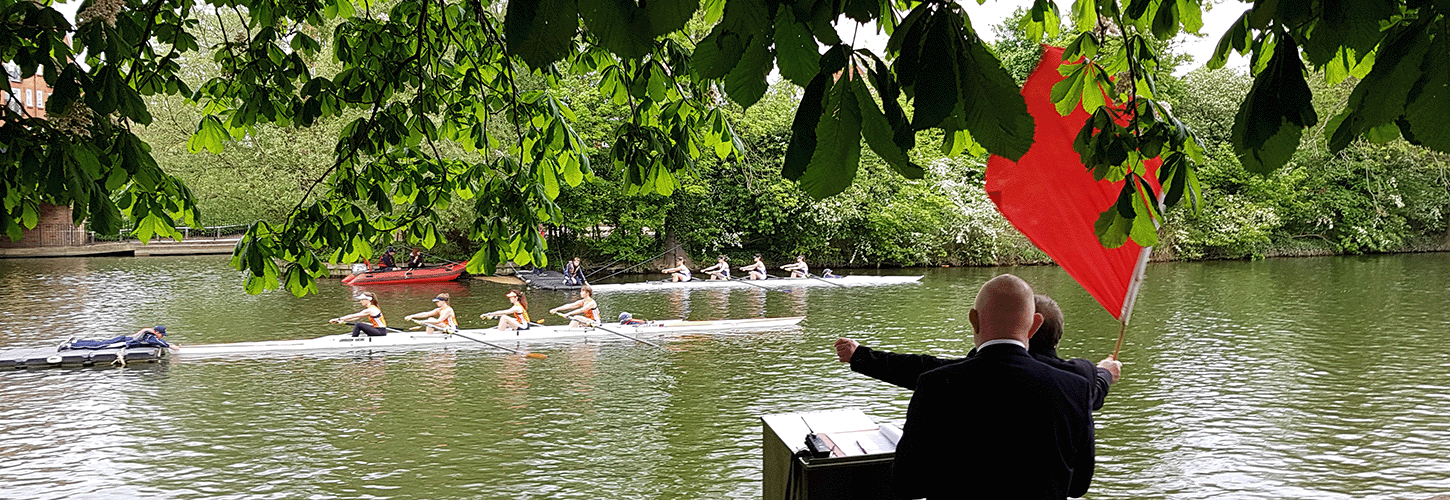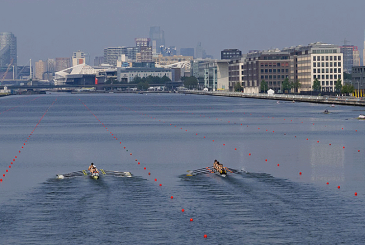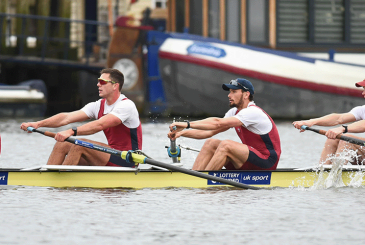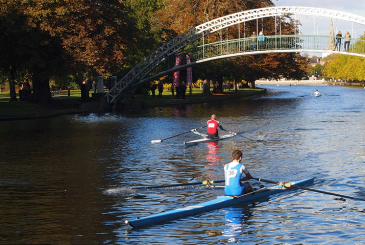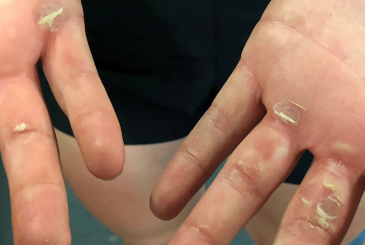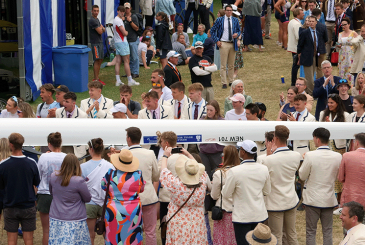Regattas are the format used for most rowing races over the spring and summer season from April to mid-September. But how do they work and what do you need to know before competing in your first regatta? Experienced cox and regatta organiser Helena Smalman-Smith explains all.
What are rowing regattas and how do they work?
The main type of racing at rowing regattas are side-by-side races in a knock-out format. The boats line up level at the start, they all set off at the same time, and the one whose bow ball crosses the finish line first wins. The winner progresses to the next round or, if the race was a final, they get the prize!
How many crews race at a time?
In traditional river regattas, only two crews race at a time. There are a few regattas that take place on wider rivers or lakes where three crews can start abreast – the Kingston regattas or the North of England Sprint Rowing Championships at Hollingworth Lake, for example. Either way, only the fastest crew goes through to the next round.
Multi-lane regattas take place on specially-built rowing lakes. Here the format is more like a 100m athletics race, where the competitors line up in marked lanes.
In England, rowing lakes include the Eton College Rowing Lake in Dorney, Holme Pierrepont County Park in Nottingham, the Docklands Regatta Centre in East London, and Peterborough. All of these have six or seven racing lanes and are 2,000m long, apart from Peterborough, which has four lanes and is 1,000m long.
The ‘progression system’ for multi-lane races will vary between regattas and even between different events within them, depending on the number of entries in that event, but it’s common for more than one crew to get through to the next round. Half of the crews in semi-final races will usually progress to the final.
Many regattas that take place on multi-lane courses and that also have a very large number of entries will often start with a time trial to reduce the number of crews down to the number that can be accommodated in the semi-finals or even just finals. In time trials, crews race up the course, one after the other, starting about 15 seconds apart. They provide a fair way of identifying the fastest crews who go through to the side-by-side races, but they’re less exciting for spectators because you can’t immediately tell who is winning, and the racing experience is different for the competitors too.
Events at regattas
Almost all regattas offer multiple events for different boat types (fours or eights, for example), sexes, age groups and levels (usually called Bands). You can find out more about the abbreviations for these that you’ll see in the order of racing/timetable, trees or results in our Beginner’s Guide to Head Racing. Regattas use the same categories as head races.
Understanding the racing programme
Two and three-lane regattas usually use a ‘tree’ diagram to show the racing programme and results, like this:

In this example, all of the rounds have taken place apart from the final. Tree diagrams contain a lot of information and some of this uses abbreviations to fit it all in. Here’s what you need to know:
- Crews are ‘drawn‘ (largely randomly although crews from the same club are often kept apart in the first round) into the positions on the tree. Entries for regattas usually close about a week before the competition. After that the organisers will then do the draw and publish it a few days later.
- There are six crews in this event so two of the crews (Curlew and Derby) had to be drawn straight through to the second round. This is known as having a ‘bye’. In this example, it means that Curlew will only have raced once before the final, while Furnivall will have raced twice. The Curlew crew will therefore be fresher, but they will also have had less practice, so there are pros and cons to having a bye.
- Race number and race time e.g. “Race 1 (09:05)” – crews will usually put their boats on the water and get into them about 20-40 minutes before their race so they can warm up and get to the start in good time. The longer the race course (see below) the earlier they’ll ‘boat’ for the race.
- Once a race has finished, the winner is written onto the tree along with the time the race took and the ‘verdict‘ (how much they won by).
- Bedford won Race 1 in a time of 4 minutes and 15 seconds, and by two (boat) lengths – that’s the distance between their bow ball and the other crew’s bow ball at the point Bedford crossed the line.
- Furnivall won Race 19 by two feet. If there’s more than about five lengths of clear water between the crews, the official verdict will probably be ‘Easily‘. This doesn’t mean that either crew wasn’t trying hard, though!
- In Race 2, Evesham ‘scratched‘ (they didn’t take part) so Furnivall had a ‘row over‘, which means they rowed up the course on their own and no time was taken (NTT). At some regattas, row overs don’t take place and the other crew just progresses through to the next round as if they had a bye.
Sometimes no time is taken even when both crews raced because of a fault with the timing system. - When it comes to the final, Curlew can have some confidence because they were faster in the semi-final, but Furnivall will realise they need to raise their game to win.
- The tree also shows you which side. lane or ‘station‘ each crew will be on. The crew at the top of the pair on the tree will be on the umpire’s left as they are following the race. The lower crew will be on the umpire’s right. Imagine that the tree was rotated anti-clockwise by 90 degrees, and that’s how the two crews will look to the umpire who is following the race and is looking down the course.
Plate events
A few regattas offer ‘plate events’, usually for younger age groups. These are for crews who lose their first round. These crews then go into a separate event so that they get a second race. The winners usually get a smaller prize than the winners of the main event.
How long are regatta races?
Most regatta races are between 500m and 2,000m. In the UK, only Henley Royal Regatta is longer than 2,000m (2,112m, in fact). Regattas that are 500m or less are usually called ‘sprints’.
Masters races at multi-lane regattas take place over 1,000m.
Regatta starts
Side-by-side regatta races have a standing start – both boats are stationary when the Umpire drops their flag and says ‘go’. To achieve this, most regattas use ‘stakeboats‘. These could be dinghies or small rafts that are moored in the river with anchors. Regattas on rowing lakes will usually use a pontoon at the end of the lake instead. A ‘stakeboat person’ will hold on to the stern of each boat and release their grip when the race starts.
Some multi-lane events on rowing lakes may not use the full length of the course. In this case, a ‘short start’ – an extra set of stakeboats – is installed half way up the course. These races always finish at the regular finish.
If the race takes place on a curved river, there will be a ‘stagger’ on either the start or at the finish line to compensate for this and make the racing fair. When the stagger is on the start, this means that one stakeboat will be in front of the other one. If the two crews were exactly the same speed, their bows would only become level exactly on the finish line.
The start procedure
Once the crews have attached their sterns to their stakeboats:
- The umpire will announce the race information. In the example above for race 1, she or he would say, “This is race 1, a heat of the Women’s coxed fours, Band 2. The winner of this race will go through to Race 18.”
- The crews make sure they are pointing in the right direction up the course, and ready (sitting forward with their blades square – vertical – in the water). If they are not, the cox or bow rower should put their hand up. This indicates to the umpire that they’re still straightening up.
- The umpire will then conduct a ‘roll call’, for example, “Crew 10, Abingdon, Crew 11, Bedford,”
- The umpire says “Attention,” raises a red flag, says “Go!” and drops the flag. Crews should start racing on the “Go!”
Be aware that once the Umpire has said “Attention”, they will not delay saying “Go!” if the cox or bow rower raises their hand to adjust. The crew can adjust if they want, but they risk the race starting while doing so. If there’s a strong gust of wind just as the umpire says “Attention,”, they will cancel the start by saying “As you were”.
For a full explanation of the start procedure, read Section 7 of the British Rowing Rules of Racing.
4 top tips for competing at your first regatta
- Read the Instructions for Competitors carefully. If you’re unsure about anything, ask an official.
- If you have time, walk the course if you can’t see both start and finish from the boating area.
- Just do what you’ve practiced in training, whether you’re rowing or coxing.
- Relax and enjoy the fun!
Further reading
Kitbag essentials: What to bring to a regatta >>
Attention, go! How to do racing starts >>
Henley Royal Regatta: A first-timer’s guide >>
Photo: Andrew Blit.


